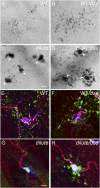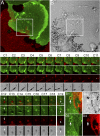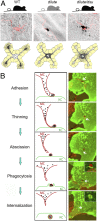Melanoregulin regulates a shedding mechanism that drives melanosome transfer from melanocytes to keratinocytes
- PMID: 22753477
- PMCID: PMC3412008
- DOI: 10.1073/pnas.1209397109
Melanoregulin regulates a shedding mechanism that drives melanosome transfer from melanocytes to keratinocytes
Abstract
Mammalian pigmentation is driven by the intercellular transfer of pigment-containing melanosomes from the tips of melanocyte dendrites to surrounding keratinocytes. Tip accumulation of melanosomes requires myosin Va, because melanosomes concentrate in the center of melanocytes from myosin Va-null (dilute) mice. This distribution defect results in inefficient melanosome transfer and a dilution of coat color. Dilute mice that simultaneously lack melanoregulin, the product of the dilute suppressor locus, exhibit a nearly complete restoration of coat color, but, surprisingly, melanosomes remain concentrated in the center of their melanocytes. Here we show that dilute/dsu melanocytes, but not dilute melanocytes, readily transfer the melanosomes concentrated in their center to surrounding keratinocytes in situ. Using time-lapse imaging of WT melanocyte/keratinocyte cocultures in which the plasma membranes of the two cells are marked with different colors, we define an intercellular melanosome transfer pathway that involves the shedding by the melanocyte of melanosome-rich packages, which subsequently are phagocytosed by the keratinocyte. Shedding, which occurs primarily at dendritic tips but also from more central regions, involves adhesion to the keratinocyte, thinning behind the forming package, and apparent self-abscission. Finally, we show that shedding from the cell center is sixfold more frequent in cultured dilute/dsu melanocytes than in dilute melanocytes, consistent with the in situ data. Together, these results explain how dsu restores the coat color of dilute mice without restoring intracellular melanosome distribution, indicate that melanoregulin is a negative regulator of melanosome transfer, and provide insight into the mechanism of intercellular melanosome transfer.
Conflict of interest statement
The authors declare no conflict of interest.
Figures








Similar articles
-
Melanoregulin is stably targeted to the melanosome membrane by palmitoylation.Biochem Biophys Res Commun. 2012 Sep 21;426(2):209-14. doi: 10.1016/j.bbrc.2012.08.064. Epub 2012 Aug 23. Biochem Biophys Res Commun. 2012. PMID: 22940130 Free PMC article.
-
Rab27a enables myosin Va-dependent melanosome capture by recruiting the myosin to the organelle.J Cell Sci. 2001 Mar;114(Pt 6):1091-100. doi: 10.1242/jcs.114.6.1091. J Cell Sci. 2001. PMID: 11228153
-
Visualization of melanosome dynamics within wild-type and dilute melanocytes suggests a paradigm for myosin V function In vivo.J Cell Biol. 1998 Dec 28;143(7):1899-918. doi: 10.1083/jcb.143.7.1899. J Cell Biol. 1998. PMID: 9864363 Free PMC article.
-
The dilute locus and Griscelli syndrome: gateways towards a better understanding of melanosome transport.Pigment Cell Res. 2001 Oct;14(5):320-7. doi: 10.1034/j.1600-0749.2001.140503.x. Pigment Cell Res. 2001. PMID: 11601653 Review.
-
Keratinocyte-melanocyte interactions during melanosome transfer.Pigment Cell Res. 2001 Aug;14(4):236-42. doi: 10.1034/j.1600-0749.2001.140402.x. Pigment Cell Res. 2001. PMID: 11549105 Review.
Cited by
-
36H: A Novel Potent Inhibitor for Antimelanogenesis.Oxid Med Cell Longev. 2018 Feb 4;2018:6354972. doi: 10.1155/2018/6354972. eCollection 2018. Oxid Med Cell Longev. 2018. PMID: 29507652 Free PMC article.
-
The Contribution of Melanoregulin to Microtubule-Associated Protein 1 Light Chain 3 (LC3) Associated Phagocytosis in Retinal Pigment Epithelium.Mol Neurobiol. 2015 Dec;52(3):1135-1151. doi: 10.1007/s12035-014-8920-5. Epub 2014 Oct 10. Mol Neurobiol. 2015. PMID: 25301234 Free PMC article.
-
Keratin intermediate filaments mechanically position melanin pigments for genome photoprotection.bioRxiv [Preprint]. 2025 Jan 15:2025.01.15.632531. doi: 10.1101/2025.01.15.632531. bioRxiv. 2025. PMID: 39868182 Free PMC article. Preprint.
-
Shining a Light on Black Holes in Keratinocytes.J Invest Dermatol. 2018 Mar;138(3):486-489. doi: 10.1016/j.jid.2017.11.002. J Invest Dermatol. 2018. PMID: 29477191 Free PMC article.
-
The Structure of Melanoregulin Reveals a Role for Cholesterol Recognition in the Protein's Ability to Promote Dynein Function.Structure. 2018 Oct 2;26(10):1373-1383.e4. doi: 10.1016/j.str.2018.07.009. Epub 2018 Aug 30. Structure. 2018. PMID: 30174147 Free PMC article.
References
MeSH terms
Substances
LinkOut - more resources
Full Text Sources
Other Literature Sources
Molecular Biology Databases

